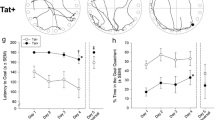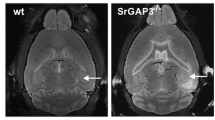Abstract
Aging is often associated with a decline in cognitive function. A reduction in the number of somatostatin-positive (SOM+) interneurons in the dentate gyrus (DG) has been described in cognitively impaired but not in unimpaired aged rodents. However, it remains unclear whether the reduction in SOM + interneurons in the DG hilus is causal for age-related cognitive dysfunction. We hypothesized that hilar SOM+ interneurons play an essential role in maintaining cognitive function and that a reduction in the number of hilar SOM + interneurons might be sufficient to induce cognitive dysfunction. Hilar SOM+ interneurons were ablated by expressing a diphtheria toxin transgene specifically in these interneurons, which resulted in a reduction in the number of SOM+ /GAD-67+ neurons and dendritic spine density in the DG. C-fos and Iba-1 immunostainings were increased in DG and CA3, but not CA1, and BDNF protein expression in the hippocampus was decreased. Behavioral testing showed a reduced recognition index in the novel object recognition test, decreased alternations in the Y maze test, and longer latencies and path lengths in the learning and reversal learning phases of the Morris water maze. Our results show that partial genetic ablation of SOM+ hilar interneurons is sufficient to increase activity in DG and CA3, as has been described to occur with aging and to induce an impairment of learning and memory functions. Thus, partial ablation of hilar SOM + interneurons may be a significant contributing factor to age-related cognitive dysfunction. These mice may also be useful as a cellularly defined model of hippocampal aging.









Similar content being viewed by others
Data Availability
All original research data will be archived in the Harvard Dataverse repository.
References
Salthouse TA (2019) Trajectories of normal cognitive aging. Psychol Aging 34:17–24. https://doi.org/10.1037/pag0000288
Berger M, Nadler JW, Browndyke J et al (2015) Postoperative cognitive dysfunction. Anesthesiol Clin 33:517–550. https://doi.org/10.1016/j.anclin.2015.05.008
Berger M, Schenning KJ, Brown CH et al (2018) Best practices for postoperative brain health. Anesth Analg 127:1406–1413. https://doi.org/10.1213/ANE.0000000000003841
Evered L, Silbert B, Knopman DS et al (2018) Recommendations for the nomenclature of cognitive change associated with anaesthesia and surgery—2018. Anesthesiology 129:872–879. https://doi.org/10.1097/ALN.0000000000002334
Moller J, Cluitmans P, Rasmussen L et al (1998) Long-term postoperative cognitive dysfunction in the elderly: ISPOCD1 study. The Lancet 351:857–861. https://doi.org/10.1016/S0140-6736(97)07382-0
Gao F, Edden RAE, Li M et al (2013) Edited magnetic resonance spectroscopy detects an age-related decline in brain GABA levels. Neuroimage 78:75–82. https://doi.org/10.1016/j.neuroimage.2013.04.012
Duarte JMN, Do KQ, Gruetter R (2014) Longitudinal neurochemical modifications in the aging mouse brain measured in vivo by 1H magnetic resonance spectroscopy. Neurobiol Aging 35:1660–1668. https://doi.org/10.1016/j.neurobiolaging.2014.01.135
Engin E, Sigal M, Benke D et al (2020) Bidirectional regulation of distinct memory domains by α5-subunit-containing GABAA receptors in CA1 pyramidal neurons. Learn Mem 27:423–428. https://doi.org/10.1101/lm.052084.120
Engin E, Zarnowska ED, Benke D et al (2015) Tonic inhibitory control of dentate gyrus granule cells by α5-containing GABAA receptors reduces memory interference. J Neurosci 35:13698–13712. https://doi.org/10.1523/JNEUROSCI.1370-15.2015
Lin C-W, Chang L-C, Ma T et al (2021) Older molecular brain age in severe mental illness. Mol Psychiatry 26:3646–3656. https://doi.org/10.1038/s41380-020-0834-1
Bareggi SR (1982) Decreased CSF concentrations of homovanillic acid and γ-aminobutyric acid in Alzheimer’s disease. Arch Neurol 39:709. https://doi.org/10.1001/archneur.1982.00510230035010
Bartsch T, Wulff P (2015) The hippocampus in aging and disease: from plasticity to vulnerability. Neuroscience 309:1–16. https://doi.org/10.1016/j.neuroscience.2015.07.084
Driscoll I, Howard SR, Stone JC et al (2006) The aging hippocampus: a multi-level analysis in the rat. Neuroscience 139:1173–1185. https://doi.org/10.1016/j.neuroscience.2006.01.040
Andrews-Zwilling Y, Gillespie AK, Kravitz AV et al (2012) Hilar GABAergic interneuron activity controls spatial learning and memory retrieval. PLoS One 7:e40555. https://doi.org/10.1371/journal.pone.0040555
Spiegel AM, Koh MT, Vogt NM et al (2013) Hilar interneuron vulnerability distinguishes aged rats with memory impairment. J Compar Neurol 521:3508–3523. https://doi.org/10.1002/cne.23367
Yassa MA, Lacy JW, Stark SM et al (2011) Pattern separation deficits associated with increased hippocampal CA3 and dentate gyrus activity in nondemented older adults. Hippocampus 21:968–979. https://doi.org/10.1002/hipo.20808
Oh MM, Simkin D, Disterhoft JF (2016) Intrinsic hippocampal excitability changes of opposite signs and different origins in CA1 and CA3 pyramidal neurons underlie aging-related cognitive deficits. Front Syst Neurosci 10:52. https://doi.org/10.3389/fnsys.2016.00052
Koh MT, Rosenzweig-Lipson S, Gallagher M (2013) Selective GABAA α5 positive allosteric modulators improve cognitive function in aged rats with memory impairment. Neuropharmacology 64:145–152. https://doi.org/10.1016/j.neuropharm.2012.06.023
Jessen SB, Mathiesen C, Lind BL, Lauritzen M (2017) Interneuron deficit associates attenuated network synchronization to mismatch of energy supply and demand in aging mouse brains. Cereb Cortex 27:646–659. https://doi.org/10.1093/cercor/bhv261
Thomé A, Gray DT, Erickson CA et al (2016) Memory impairment in aged primates is associated with region-specific network dysfunction. Mol Psychiatry 21:1257–1262. https://doi.org/10.1038/mp.2015.160
Sohal VS, Zhang F, Yizhar O, Deisseroth K (2009) Parvalbumin neurons and gamma rhythms enhance cortical circuit performance. Nature 459:698–702. https://doi.org/10.1038/nature07991
Waller R, Mandeya M, Viney E et al (2020) Histological characterization of interneurons in Alzheimer’s disease reveals a loss of somatostatin interneurons in the temporal cortex. Neuropathology 40:336–346. https://doi.org/10.1111/neup.12649
Koh MT, Spiegel AM, Gallagher M (2014) Age-associated changes in hippocampal-dependent cognition in Diversity Outbred mice. Hippocampus 24:1300–1307. https://doi.org/10.1002/hipo.22311
Lyu J, Nagarajan R, Kambali M et al (2023) Selective inhibition of somatostatin-positive dentate hilar interneurons induces age-related cellular changes and cognitive dysfunction. PNAS Nexus 2:pgad134. https://doi.org/10.1093/pnasnexus/pgad134
Bevins RA, Besheer J (2006) Object recognition in rats and mice: a one-trial non-matching-to-sample learning task to study “recognition memory.” Nat Protoc 1:1306–1311. https://doi.org/10.1038/nprot.2006.205
Vorhees CV, Williams MT (2006) Morris water maze: procedures for assessing spatial and related forms of learning and memory. Nat Protoc 1:848–858. https://doi.org/10.1038/nprot.2006.116
Kraeuter AK, Guest PC, Sarnyai Z (2019) The Y-Maze for assessment of spatial working and reference memory in mice. Methods Mol Biol 1916:105–111. https://doi.org/10.1007/978-1-4939-8994-2_10
Rajasekar N, Nath C, Hanif K, Shukla R (2017) Intranasal insulin administration ameliorates streptozotocin (ICV)-induced insulin receptor dysfunction, neuroinflammation, amyloidogenesis, and memory impairment in rats. Mol Neurobiol 54:6507–6522. https://doi.org/10.1007/s12035-016-0169-8
Risher WC, Ustunkaya T, Singh Alvarado J, Eroglu C (2014) Rapid Golgi analysis method for efficient and unbiased classification of dendritic spines. PLoS One 9:e107591. https://doi.org/10.1371/journal.pone.0107591
Yuan M, Meyer T, Benkowitz C et al (2017) Somatostatin-positive interneurons in the dentate gyrus of mice provide local- and long-range septal synaptic inhibition. Elife 6:e21105. https://doi.org/10.7554/eLife.21105
Hudson AE (2018) Genetic reporters of neuronal activity: c-Fos and G-CaMP6. Methods Enzymol 603:197–220. https://doi.org/10.1016/bs.mie.2018.01.023
Oh H, Lewis DA, Sibille E (2016) The role of BDNF in age-dependent changes of excitatory and inhibitory synaptic markers in the human prefrontal cortex. Neuropsychopharmacology 41:3080–3091. https://doi.org/10.1038/npp.2016.126
Andrews-Zwilling Y, Bien-Ly N, Xu Q et al (2010) Apolipoprotein E4 causes age- and tau-dependent impairment of GABAergic interneurons, leading to learning and memory deficits in mice. J Neurosci 30:13707–13717. https://doi.org/10.1523/JNEUROSCI.4040-10.2010
Beal MF, Mazurek MF, Tran VT et al (1979) (1985) Reduced numbers of somatostatin receptors in the cerebral cortex in Alzheimer’s disease. Science 229:289–291. https://doi.org/10.1126/science.2861661
Davies P, Katzman R, Terry RD (1980) Reduced somatostatin-like immunoreactivity in cerebral cortex from cases of Alzheimer disease and Alzheimer senile dementa. Nature 288:279–280. https://doi.org/10.1038/288279a0
Dournaud P, Delaere P, Hauw JJ, Epelbaum J (1995) Differential correlation between neurochemical deficits, neuropathology, and cognitive status in Alzheimer’s disease. Neurobiol Aging 16:817–823. https://doi.org/10.1016/0197-4580(95)00086-T
Dawbarn D, Rossor MN, Mountjoy CQ et al (1986) Decreased somatostatin immunoreactivity but not neuropeptide Y immunoreactivity in cerebral cortex in senile dementia of Alzheimer type. Neurosci Lett 70:154–159. https://doi.org/10.1016/0304-3940(86)90455-6
Freund TF, Buzsáki G (1998) Interneurons of the hippocampus. Hippocampus 6:347–470. https://doi.org/10.1002/(SICI)1098-1063(1996)6:4%3c347::AID-HIPO1%3e3.0.CO;2-I
Houser CR (2007) Interneurons of the dentate gyrus: an overview of cell types, terminal fields and neurochemical identity. Prog Brain Res 163:217–232. https://doi.org/10.1016/S0079-6123(07)63013-1
Lau CG, Murthy VN (2012) Activity-dependent regulation of inhibition via GAD67. J Neurosci 32:8521–8531. https://doi.org/10.1523/JNEUROSCI.1245-12.2012
Bakker A, Krauss GL, Albert MS et al (2012) Reduction of hippocampal hyperactivity improves cognition in amnestic mild cognitive impairment. Neuron 74:467–474. https://doi.org/10.1016/j.neuron.2012.03.023
Wilson IA (2005) Age-associated alterations of hippocampal place cells are subregion specific. J Neurosci 25:6877–6886. https://doi.org/10.1523/JNEUROSCI.1744-05.2005
Beheshti F, Vakilian A, Navari M et al (2023) Effects of Ocimum basilicum L. extract on hippocampal oxidative stress, inflammation, and BDNF expression in amnesic aged rats. Exp Aging Res 1–16. https://doi.org/10.1080/0361073X.2023.2210240
von Bohlen und Halbach O, Zacher C, Gass P, Unsicker K (2006) Age-related alterations in hippocampal spines and deficiencies in spatial memory in mice. J Neurosci Res 83:525–531. https://doi.org/10.1002/jnr.20759
Mahmmoud RR, Sase S, Aher YD et al (2015) Spatial and working memory is linked to spine density and mushroom spines. PLoS One 10:e0139739. https://doi.org/10.1371/journal.pone.0139739
Acknowledgements
The research reported in this study was supported by the National Institute of General Medical Sciences of the National Institutes of Health under award number R01GM128183 to U.R. The content is solely the responsibility of the authors and does not necessarily represent the official views of the National Institutes of Health. We thank Dr. CheMyong Ko for providing access to his microscopes.
Author information
Authors and Affiliations
Contributions
Conceptualization: UR; investigation: RN; analysis and interpretation: RN, JL, UR; methodology: RN, JL, MK, MW, CAC-H, CDC, UR; funding acquisition: UR; supervision: UR; writing – original draft: RN, UR; writing – review and editing: RN, JL, MK, MW, CDC, CAC-H, UR.
Corresponding author
Ethics declarations
Conflict of Interest
Uwe Rudolph is a Scientific Advisor to Damona Pharmaceuticals. The other authors declare no competing interests.
Additional information
Publisher's Note
Springer Nature remains neutral with regard to jurisdictional claims in published maps and institutional affiliations.
Rights and permissions
Springer Nature or its licensor (e.g. a society or other partner) holds exclusive rights to this article under a publishing agreement with the author(s) or other rightsholder(s); author self-archiving of the accepted manuscript version of this article is solely governed by the terms of such publishing agreement and applicable law.
About this article
Cite this article
Nagarajan, R., Lyu, J., Kambali, M. et al. Genetic Ablation of Dentate Hilar Somatostatin-Positive GABAergic Interneurons is Sufficient to Induce Cognitive Impairment. Mol Neurobiol 61, 567–580 (2024). https://doi.org/10.1007/s12035-023-03586-3
Received:
Accepted:
Published:
Issue Date:
DOI: https://doi.org/10.1007/s12035-023-03586-3




